If you’re experiencing a recurring issue with your air conditioning system where the AC capacitor keeps blowing, you’re likely dealing with a frustrating and potentially costly problem. The capacitor is a crucial component that helps start and run the motors in your AC unit. When it repeatedly fails, it can lead to frequent system breakdowns, discomfort in your home, and increased expenses.
In this article, we will explore the possible causes behind a blown AC capacitor, signs to look out for, and most importantly, what steps you can take to address the issue effectively.
By understanding the underlying factors and taking appropriate actions, you can resolve the problem and ensure your air conditioning system operates reliably and efficiently.
What is an AC Capacitor?
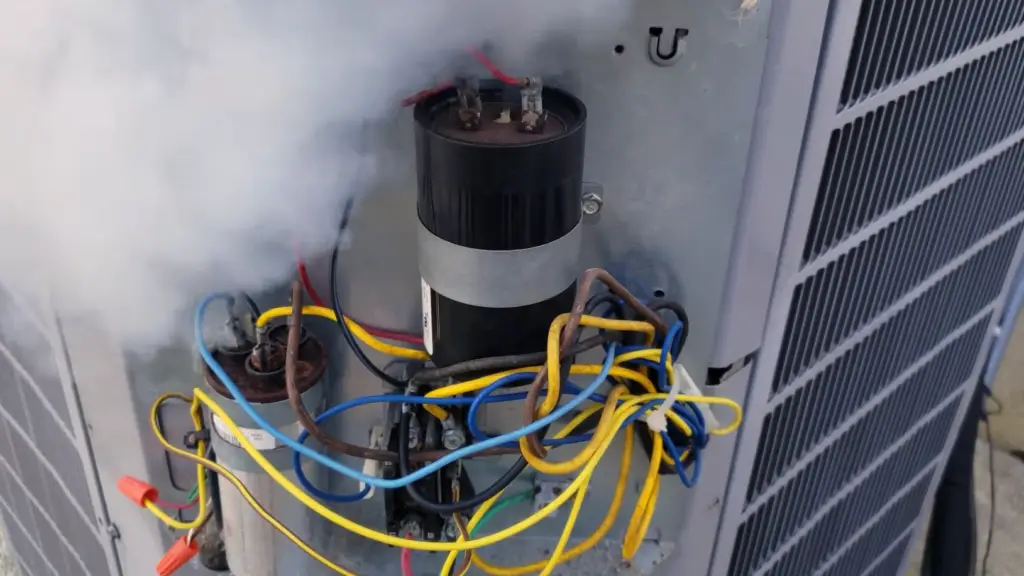
Capacitors, in general, are passive electronic components that can store and discharge electrical energy. They consist of two conducting plates, usually made of metal, separated by an insulating material known as a dielectric. When a voltage is applied across the plates, an electric field is formed, causing the accumulation of electric charges on the plates.
In an AC capacitor, the dielectric used is specifically chosen to withstand the alternating current’s constant changes in polarity. This enables the capacitor to store and release energy in synchronization with the alternating current waveform. Common dielectric materials used in AC capacitors include ceramic, plastic film, tantalum, and electrolytic capacitors.
The primary function of an AC capacitor is to improve the power factor of electrical circuits. Power factor is a measure of how effectively a device uses electrical power, and it is influenced by the presence of reactive power. Reactive power arises due to the phase difference between voltage and current in AC circuits. By introducing a capacitor, which stores and releases reactive power, the power factor can be adjusted to a more desirable level.
AC capacitors are commonly used in various applications, including air conditioning systems, motor starters, power supplies, and electronic circuits. In air conditioning systems, for instance, capacitors are used in the compressor and fan motors to provide the necessary starting torque. They help overcome the initial resistance and ensure a smooth start for the motors.
How Does an AC Capacitor Work?
An AC capacitor works based on the principles of capacitance and the storage and release of electrical energy. When an alternating current (AC) is applied to a capacitor, it charges and discharges in synchronization with the alternating voltage waveform.
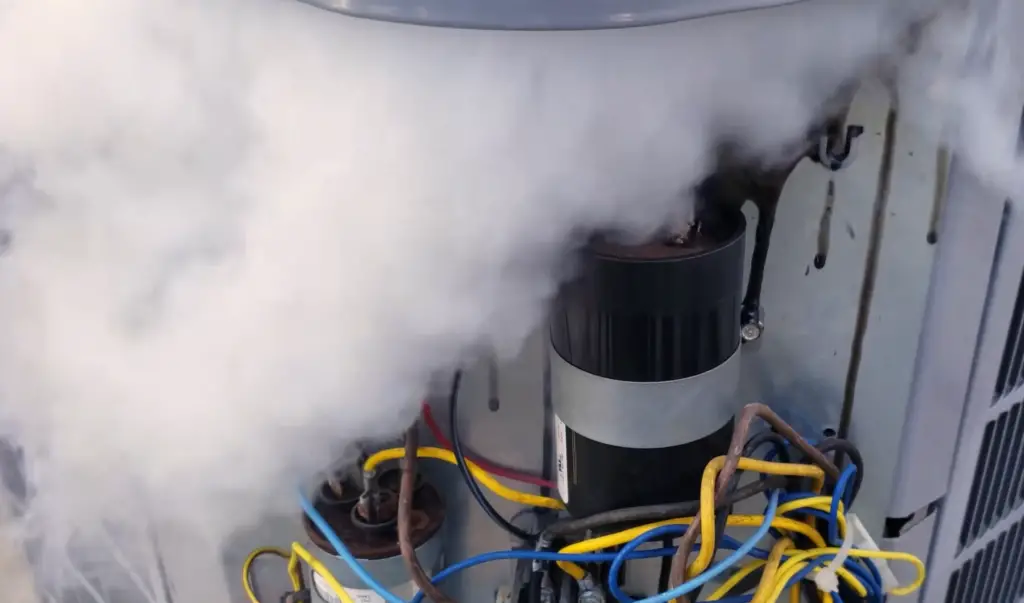
The basic structure of an AC capacitor consists of two conducting plates, usually made of metal, separated by an insulating material called a dielectric. The dielectric is chosen specifically to withstand the alternating current’s constant changes in polarity. Common dielectric materials used in AC capacitors include ceramic, plastic film, tantalum, and electrolytic capacitors [2].
When an AC voltage is applied across the plates of the capacitor, it creates an electric field between them. As the voltage alternates, the electric field also changes direction, causing charges to accumulate on the capacitor plates. During the positive half-cycle of the AC voltage, one plate becomes positively charged, while the other becomes negatively charged. In the negative half-cycle, the charges reverse their polarity.
The capacitance is determined by factors such as the area of the plates, the distance between them, and the dielectric material’s properties. A higher capacitance value means that the capacitor can store more charge for a given voltage.
The stored charge in the capacitor can be calculated using the formula Q = CV, where Q represents the charge in coulombs, C is the capacitance in farads, and V is the voltage applied across the capacitor. As the voltage alternates, the capacitor charges and discharges repeatedly, storing and releasing energy with each cycle.
The energy stored in the capacitor can be used in various applications. For example, in air conditioning systems, capacitors are used to provide the necessary starting torque for compressor and fan motors. When the motor is initially powered, the capacitor discharges, providing an additional electrical boost to overcome the motor’s initial resistance and ensure a smooth start.
In electronic circuits, AC capacitors are often used for filtering and stabilizing voltage levels. They act as energy reservoirs, smoothing out fluctuations in the power supply. Capacitors are frequently combined with other components to create filters that remove unwanted noise or ripple from a signal or timing circuits that control the timing of events in a circuit.

It’s important to note that AC capacitors have voltage and capacitance ratings, and it’s crucial to select the appropriate capacitor for a given application. Using an incorrectly rated capacitor can lead to inefficient operation, overheating, or even failure of the equipment.
What Causes a Blown AC Capacitor:
1. Power Surges
Power surges, which are sudden increases in voltage, can overwhelm and damage AC capacitors. These surges can occur due to lightning strikes, utility grid fluctuations, or even when large appliances in the home turn on and off. The excessive voltage can cause the capacitor to fail or rupture [3].
2. Short Circuits
A short circuit, which is an unintended connection between two points of low resistance, can lead to a blown capacitor. When a short circuit occurs in the electrical system, it can cause an excessive flow of current through the capacitor, exceeding its capacity and resulting in failure.
3. System Overheating
Overheating is another common cause of capacitor failure. Air conditioning systems generate heat while operating, and if the system is unable to dissipate this heat properly, it can lead to elevated temperatures within the capacitor. The excessive heat can degrade the capacitor’s dielectric material, causing it to break down and fail.
4. Wrong Voltage Rating
Using a capacitor with the wrong voltage rating can lead to its failure. Capacitors are designed to operate within a specific voltage range, and using a capacitor with a lower voltage rating than what is required can cause it to become overwhelmed and blow. Similarly, using a capacitor with a higher voltage rating may not provide adequate protection, and the capacitor could still fail due to other factors.
5. Damaged Parts
If other components in the air conditioning system, such as the compressor or fan motor, are faulty or damaged, it can put excessive strain on the capacitor. The increased stress on the capacitor can lead to its failure over time.
6. Capacitor Getting Older
Capacitors have a limited lifespan, and as they age, their performance and reliability can deteriorate. Over time, the dielectric material can degrade, reducing the capacitor’s ability to store and release energy efficiently. This can ultimately lead to the capacitor failing or blowing.
To prevent blown AC capacitors, regular maintenance and inspections of the air conditioning system are crucial. It’s important to address any issues promptly, such as fixing faulty components, ensuring proper airflow for cooling, and using capacitors with the correct voltage rating. Additionally, installing surge protection devices can help safeguard against power surges.

What Are The Signs of a Faulty AC Capacitor:
1. Burning Smell or Smoke
If you notice a burning smell or see smoke coming from your AC unit, it could be a sign of a faulty capacitor. Overheating or internal damage to the capacitor can cause it to emit a burning odor or produce smoke. This is a serious issue and should be addressed immediately to prevent further damage or potential hazards.
2. Humming Noise
A faulty capacitor may produce a humming or buzzing noise. This noise is often a result of electrical arcing or the capacitor struggling to start properly.
3. Slow Cooling Cycle
When the capacitor is not functioning correctly, it can lead to a slower cooling cycle. You may notice that your AC system takes longer than usual to reach the desired temperature or fails to cool the space adequately. This inefficiency is a clear indication that the capacitor may be faulty and needs attention.
4. AC System Shuts Down Randomly
A faulty capacitor can cause the AC system to shut down unexpectedly. This may happen intermittently or more frequently, disrupting the cooling process and leaving you with an uncomfortable indoor environment. If your AC system shuts down randomly, it is advisable to have it inspected to identify the underlying cause, which could be a faulty capacitor.
5. AC Doesn’t Work at All
If your AC system fails to turn on or doesn’t work at all, it could be a result of a faulty capacitor. The capacitor plays a crucial role in the starting process of the AC unit. When it fails, the AC system may not receive the necessary electrical boost to initiate operation.
6. AC Doesn’t Blow Any Cold Air
A faulty capacitor can also lead to a lack of cold air blowing from the AC vents. If you notice that your AC system is running but only blows warm or room-temperature air, it could indicate a problem with the capacitor. The capacitor’s failure can impact the proper functioning of the compressor, which is responsible for cooling the air.
7. Energy Bills Are Higher than Expected
A faulty capacitor can result in decreased energy efficiency of the AC system. When the capacitor is not operating optimally, it can cause the AC unit to consume more energy to achieve the desired cooling effect. If you notice a sudden increase in your energy bills without any other apparent reason, a faulty capacitor could be a contributing factor.
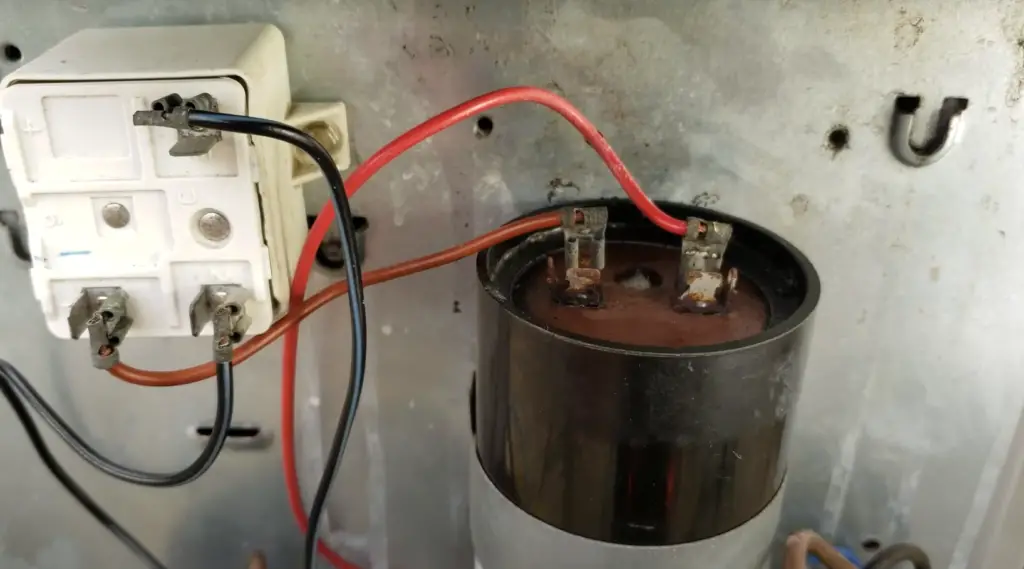
8. Your Bad AC Capacitor Looks Like It Died
In some cases, a faulty capacitor may show visible signs of damage. You might notice bulging, leaking, or corroded terminals on the capacitor. These physical indications suggest that the capacitor is no longer functioning properly and needs to be replaced.
If you experience any of these signs or suspect a faulty AC capacitor, it is recommended to have a professional HVAC technician inspect and diagnose the issue. They can accurately identify the problem and provide the necessary repairs or replacements to restore your AC system’s functionality [4].
How to Check the Air Conditioning Capacitor:
1. Multimeter Using Capacitance Setting
A multimeter with a capacitance setting is the most accurate method to check the capacitance of an AC capacitor. Follow these steps:
- Ensure the power to the AC unit is turned off and disconnect it from the electrical supply;
- Locate the capacitor in the AC unit. It is typically a cylindrical or box-shaped device;
- Set your multimeter to the capacitance setting. The symbol for capacitance is usually indicated as “F” or “μF” on the multimeter dial;
- Discharge the capacitor by shorting the terminals with an insulated screwdriver or a wire with an alligator clip;
- Connect the multimeter leads to the corresponding terminals of the capacitor, observing the polarity (positive and negative);
- Read the capacitance value displayed on the multimeter. Compare it with the manufacturer’s specified capacitance range. If the reading is significantly lower or higher, it indicates a faulty capacitor that needs replacement;
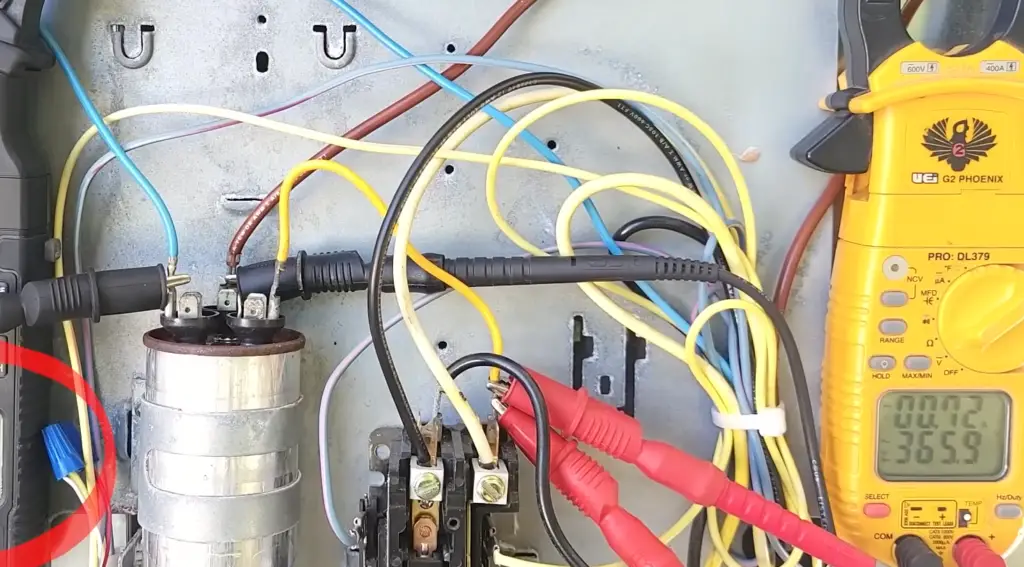
2. Multimeter Without a Capacitance Setting
If your multimeter does not have a capacitance setting, you can still perform a basic test to check the continuity of the capacitor. Follow these steps:
- Make sure the power to the AC unit is turned off and disconnect it from the electrical supply;
- Locate the capacitor in the AC unit;
- Set your multimeter to the resistance or ohms setting;
- Discharge the capacitor by shorting the terminals with an insulated screwdriver or a wire with an alligator clip;
- Connect the multimeter leads to the terminals of the capacitor, observing the polarity;
- The resistance reading on the multimeter should start low and gradually increase. If the multimeter shows infinite resistance or does not change at all, it indicates a faulty capacitor;
- Please note that this method only provides a basic indication of continuity and does not measure the capacitance value accurately;

3. Voltmeter
A voltmeter can also be used to perform a visual test on the capacitor’s charging and discharging capabilities. Follow these steps:
- Make sure the power to the AC unit is turned off and disconnect it from the electrical supply;
- Locate the capacitor in the AC unit;
- Set your voltmeter to the AC voltage setting;
- Discharge the capacitor by shorting the terminals with an insulated screwdriver or a wire with an alligator clip;
- Connect the voltmeter leads to the corresponding terminals of the capacitor, observing the polarity.
- Restore power to the AC unit momentarily by turning it on. Observe the voltmeter reading. It should rise and then gradually drop as the capacitor discharges;
- If the voltmeter shows no increase or decrease in voltage, or if the voltage remains constant, it indicates a faulty capacitor;
- While a voltmeter can provide a rough indication of the capacitor’s health, it does not provide an accurate measurement of the capacitance value;
Remember, if you are unsure or uncomfortable performing these checks, it is recommended to seek assistance from a qualified HVAC technician. They have the expertise and tools to accurately diagnose and address capacitor issues in your air conditioning system [5].
How to Fix a Bad AC Capacitor?
Fixing a bad AC capacitor typically involves replacing the faulty capacitor with a new one. Here’s a step-by-step guide on how to fix a bad AC capacitor:
- Safety First: Ensure the power to the AC unit is turned off and disconnected from the electrical supply. This step is crucial to prevent any potential electrical hazards;
- Identify the Faulty Capacitor: Locate the faulty capacitor in your AC unit. It is usually a cylindrical or box-shaped device with two or three terminals;
- Take Note of Capacitor Specifications: Note down the specifications of the faulty capacitor, including the capacitance value (measured in farads or microfarads), voltage rating, and terminal configuration. These specifications are essential when purchasing a replacement capacitor;
- Purchase a Replacement Capacitor: Visit a local HVAC supply store or purchase a compatible replacement capacitor online. Ensure that the replacement capacitor matches the specifications of the faulty one;
- Discharge the Capacitor: Before removing the faulty capacitor, discharge it to prevent any residual electrical charge. You can use an insulated screwdriver or a wire with an alligator clip to short the terminals of the capacitor together;
- Remove the Faulty Capacitor: Carefully disconnect the wires or terminals connected to the faulty capacitor. Take note of their positions or use a camera to capture their arrangement for reconnection later. Unscrew or unclip the faulty capacitor from its mounting bracket;
- Install the Replacement Capacitor: Install the new capacitor in the same position as the old one, ensuring it is securely fastened to the mounting bracket. Connect the wires or terminals to their corresponding positions on the new capacitor, following the same configuration as before;
- Reconnect the Power Supply: Once the new capacitor is securely installed and wired correctly, reconnect the power supply to the AC unit;
- Test the AC System: Turn on the AC system and observe its operation. Check if the cooling cycles are functioning correctly and if the AC blows cold air;
- Monitor Performance: Keep an eye on the AC system’s performance for a while to ensure that the replacement capacitor has resolved the issue. If you notice any ongoing problems or if the AC system does not operate as expected, it is advisable to contact a professional HVAC technician for further inspection and assistance;
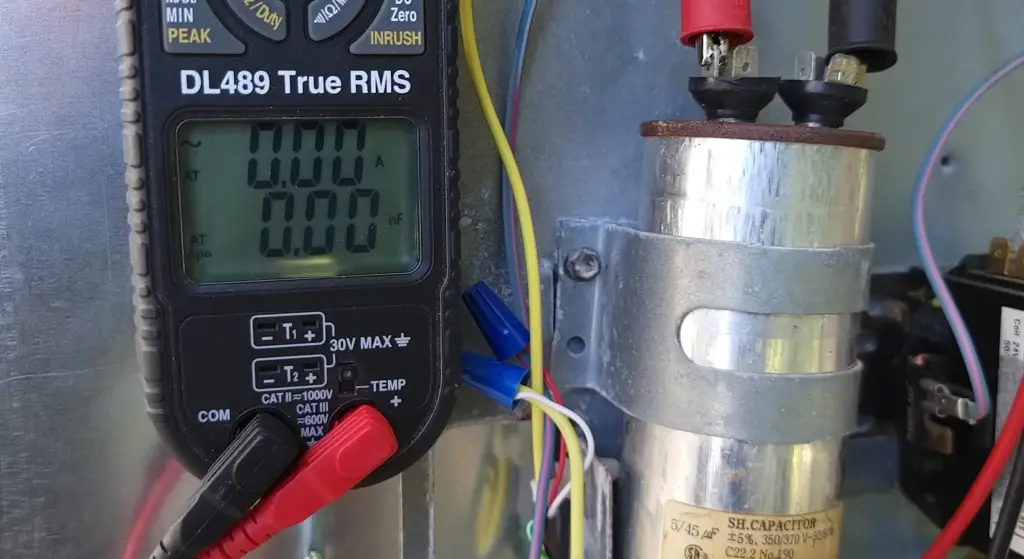
FAQ:
1. How does a capacitor store energy?
A capacitor stores energy by utilizing an electrostatic field between two conductive plates separated by an insulating material, known as a dielectric. When a voltage is applied across the capacitor, positive charges accumulate on one plate, while negative charges accumulate on the other plate. This separation of charges creates an electric field, storing electrical energy in the capacitor’s electric field.
2. What causes a blown capacitor in your air conditioner?
Several factors can cause a blown capacitor in an air conditioner, including power surges, short circuits, system overheating, using capacitors with the wrong voltage rating, damaged components, or the natural aging process of the capacitor [6].
3. How do you know if your air conditioner has a blown capacitor?
Some signs of a blown capacitor in an air conditioner include a burning smell, humming noise, slow cooling cycle, random system shutdowns, AC not working at all or not blowing cold air, higher than expected energy bills, or visible signs of physical damage on the capacitor.
4. What should you do if you think your air conditioner has a blown capacitor?
If you suspect a blown capacitor in your air conditioner, it is recommended to turn off the power to the unit, disconnect it from the electrical supply, and contact a professional HVAC technician to inspect, diagnose, and replace the faulty capacitor if necessary.
5. Where is the AC capacitor?
The AC capacitor is typically located inside the outdoor condenser unit or the indoor air handler unit of the air conditioning system. It can usually be found near the compressor or the blower motor.
6. How long does an air conditioning capacitor last?
The lifespan of an air conditioning capacitor can vary depending on factors such as usage, environmental conditions, and quality of the capacitor. On average, capacitors can last anywhere from 10 to 20 years [7].
7. Why does my AC capacitor keep going out?
There can be several reasons why an AC capacitor keeps going out, including power surges, voltage fluctuations, poor capacitor quality, overheating of the system, improper installation, or underlying issues with other components in the AC system.
8. Why does my AC keep blowing capacitors?
If your AC keeps blowing capacitors repeatedly, it could be a symptom of an underlying issue in the electrical system, such as voltage irregularities, short circuits, or a failing compressor or motor. It is crucial to have a professional technician diagnose and address the root cause of the problem.
9. How do you fix a blown AC capacitor?
To fix a blown AC capacitor, it is generally recommended to replace the faulty capacitor with a new one. This should be done by a professional HVAC technician to ensure proper installation and compatibility [8].
10. Will AC run with a blown capacitor?
In some cases, an AC system may still run with a blown capacitor, but it may not operate efficiently or produce cold air. It is advisable to have the capacitor replaced as soon as possible to avoid further damage to the system.
11. How many years does an AC capacitor last?
The lifespan of an AC capacitor can vary, but on average, it can last between 5 to 15 years [9]. Regular maintenance and inspections can help identify any potential issues and extend the lifespan of the capacitor.
12. What are the two typical signs that a capacitor is bad or has failed?
Two typical signs that a capacitor is bad or has failed are bulging or leaking of the capacitor, and a visibly burned or damaged appearance.
13. Can I put a bigger capacitor in my AC unit?
It is not recommended to put a bigger capacitor in your AC unit unless advised by a professional technician. The capacitor size should match the manufacturer’s specifications to ensure proper functioning and prevent potential damage to the system.
14. Are AC capacitors expensive?
The cost of AC capacitors can vary depending on their size, type, and brand. Generally, AC capacitors are relatively inexpensive compared to other components of the air conditioning system.
15. When should an AC capacitor be replaced?
AC capacitors should be replaced if they show signs of damage, have physical deformities, or if they fail to operate within the manufacturer’s specified capacitance and voltage rating. Additionally, if other components in the system are being replaced, it is often recommended to replace the capacitor as a preventive measure.
16. How many capacitors are in an AC unit?
An AC unit typically has multiple capacitors. The exact number can vary depending on the design and configuration of the specific AC system, but common configurations include one or two capacitors for the compressor and one capacitor for the fan motor.
17. Why is my AC not cooling after replacing the capacitor?
If your AC is not cooling after replacing the capacitor, it could indicate an underlying issue, such as a compressor or refrigerant problem. It is best to consult with a professional technician to diagnose and resolve the issue.
18. Does a bad AC capacitor smell?
A bad AC capacitor can emit a burning smell or produce smoke, especially when it overheats or experiences internal damage. If you notice such odors, it is essential to address the issue promptly to prevent further damage or potential hazards.
19. Do AC capacitors overheat and stop working?
Yes, AC capacitors can overheat due to various factors such as voltage irregularities, poor quality, or excessive demand. Overheating can cause them to stop working or perform inadequately.
20. Can I bypass the AC capacitor?
Bypassing the AC capacitor is not recommended. Capacitors play a crucial role in the proper functioning of the AC system. Attempting to bypass the capacitor can lead to further damage to the system and compromise its performance.
21. Can I use any capacitor on my AC?
No, it is crucial to use a capacitor that matches the specifications recommended by the AC manufacturer. Using an incompatible or incorrect capacitor can result in damage to the system and may pose safety risks.
22. Do all AC motors need a capacitor?
Not all AC motors require a capacitor. Capacitors are commonly used in single-phase AC motors to provide the necessary phase shift and starting torque. However, three-phase AC motors do not typically require capacitors.
23. How can I extend the life of my AC capacitor?
To extend the life of your AC capacitor, ensure proper maintenance of your AC system, including regular cleaning, checking for loose connections, monitoring voltage levels, and scheduling routine inspections by a professional HVAC technician.
24. What is the average cost to replace an AC capacitor?
The cost to replace an AC capacitor can vary depending on factors such as the type and size of the capacitor, labor costs, and location. On average, the cost can range from $100 to $400, including parts and labor.
25. How often do AC capacitors break?
The frequency at which AC capacitors break can vary depending on factors such as the quality of the capacitor, environmental conditions, and usage. On average, capacitors can last between 5 to 15 years before they may require replacement or show signs of failure. Regular maintenance and inspections can help identify potential issues and prevent sudden failures.
Useful Video: WHY CAPACITORS FAIL in Air Conditioners! Watch it Break!
References
- https://phyxter.ai/blog/blown-ac-capacitor
- https://www.hydesac.com/what-happens-when-your-air-conditioner-has-a-blown-capacitor/
- https://www.electronicstalk.org/ac-capacitor-keeps-blowing/
- https://jerrykelly.com/how-a-blown-capacitor-can-lead-to-an-air-conditioner-breakdown/
- https://www.abchomeandcommercial.com/blog/why-my-ac-capacitor-keeps-going-out/
- https://modecomfort.com/2020/08/04/what-is-a-capacitor-and-why-do-they-keep-failing/
- https://sanbornsac.com/bad-ac-capacitor-symptoms/
- https://williamscomfortair.com/knowledge-center/bad-ac-capacitor-symptoms/





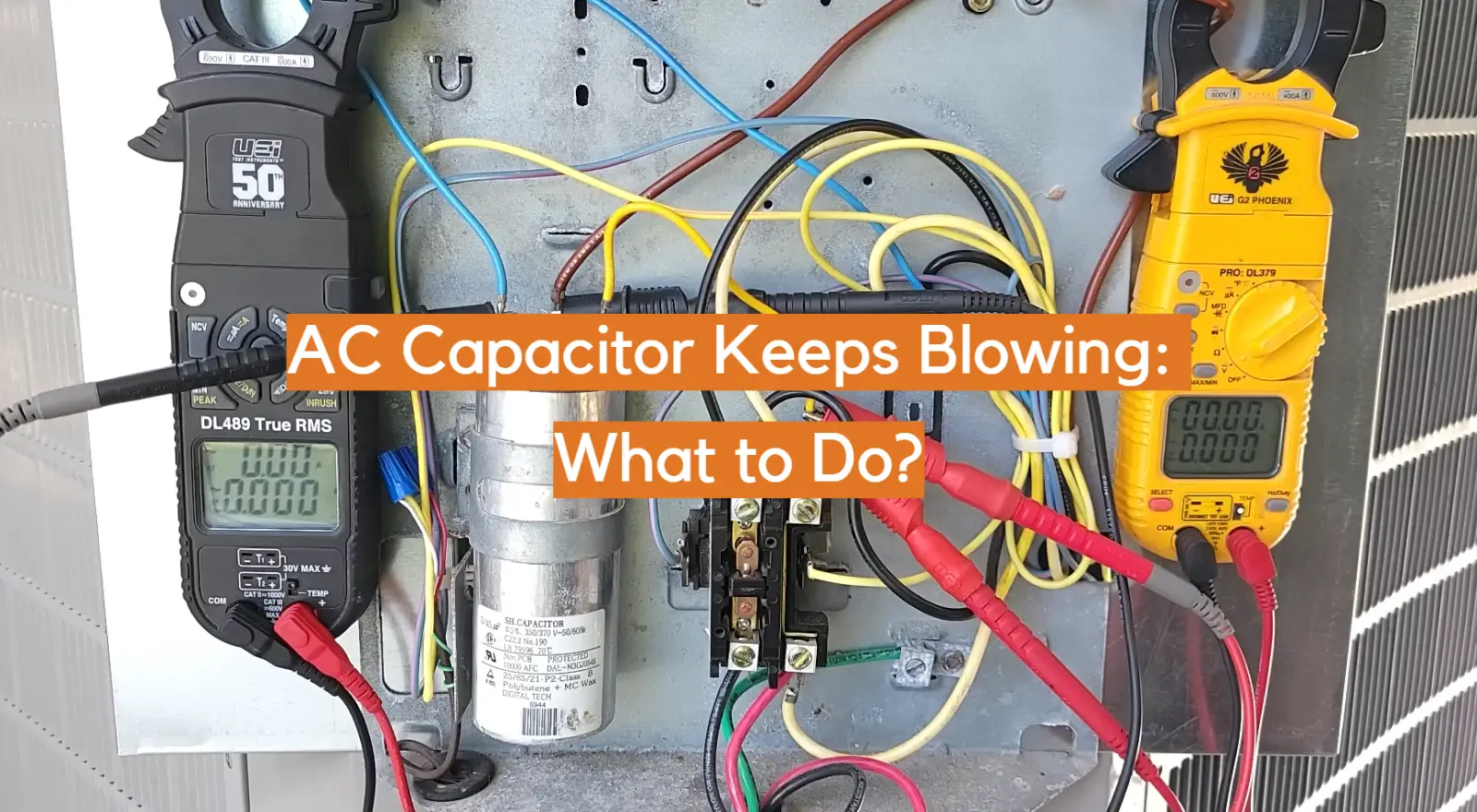







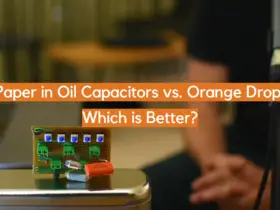
Leave a Reply